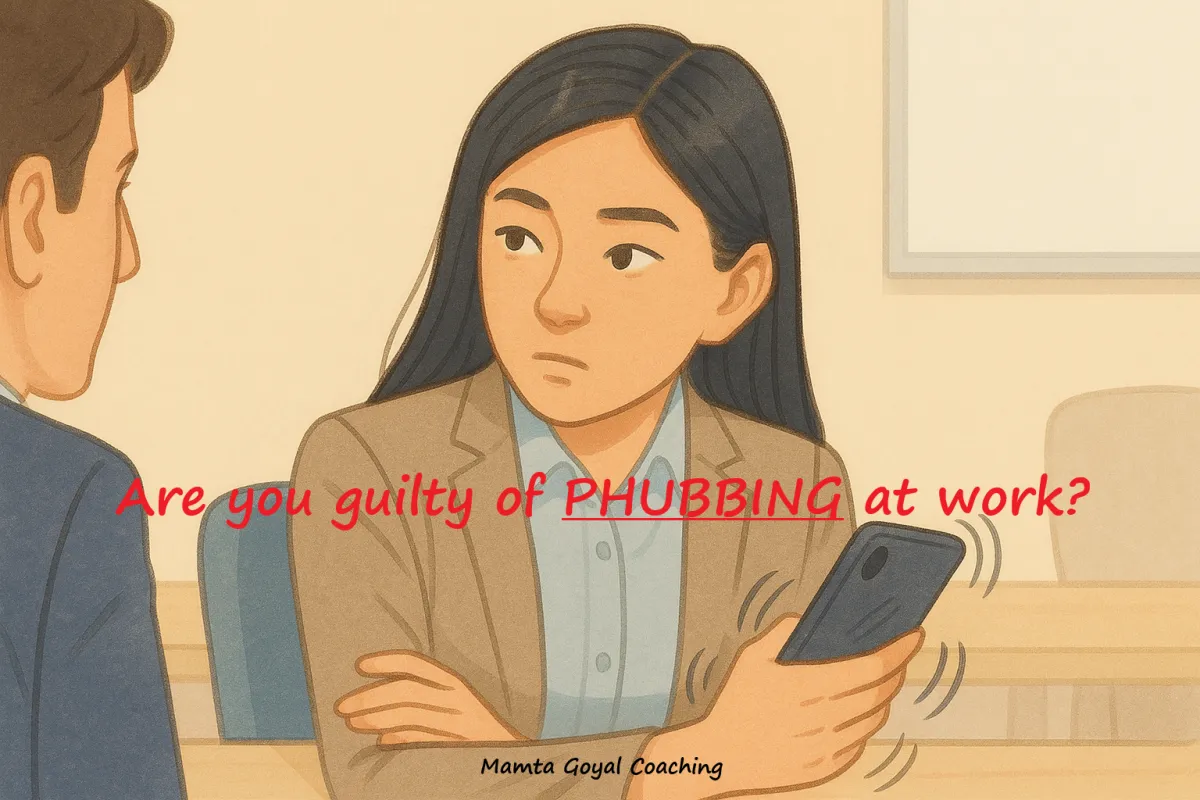
💡 No Phubbing: How to ACE Your Distraction and Become Indistractable
💡 No Phubbing: How to ACE Your Distraction and Become Indistractable
You’re in a one-on-one with a team member.
They’re sharing something that clearly matters to them — an idea, a frustration, maybe both.
Your phone buzzes.
You glance down — “just for a second.”
By the time you look up, their tone has changed.
The openness is gone.
I’ve done that before — and regretted it every time.
That tiny act even has a name: phubbing — phone + snubbing.
And it’s doing more harm at work than we realize.

📱 The Workplace Cost of Phubbing
Phubbing was coined in 2012 by an Australian team working with the Macquarie Dictionary. They wanted a word to describe the growing habit of ignoring people in favor of a phone. A decade later, that habit has followed us into our meetings, team huddles, and one-on-ones.
The research is clear: when we divide our attention, trust and engagement decline.
📊 What the Research Shows

🧭 Leadership in the Age of Distraction
In the past, leadership presence was about what you said and how you carried yourself.
Now, it’s also about where your attention goes.
When leaders split focus between people and screens, they send a message — even without words:
“Something else matters more right now.”
Over time, that message builds distance. People stop sharing openly. Meetings lose energy. The team learns that attention is optional.
Presence is no longer a soft skill. It’s operational currency.
⚡ Introducing the ACE Framework
ACE your distraction and become indistractable.
Three small shifts make a big difference:
A — Attention
Put the phone away.
Silence notifications. Close the laptop lid.
Give people your full focus.
When attention is divided, trust feels divided too.
Try a simple reset: for the first five minutes of any conversation, commit to being fully present. That single act can change how others experience working with you.
C — Connection
Listen with curiosity.
Ask one follow-up question before offering your view.
Use simple signals — “Tell me more,” “I see,” “What do you think?”
Connection isn’t built through speeches; it’s built through moments of acknowledgment.
When we look up and engage fully, people feel seen.
E — Evaluation
Reflect after key interactions:
Did I make them feel heard?
Did I model the focus I expect from others?
How did my presence—or distraction—affect the outcome?
Attention, connection, and reflection reinforce one another. Over time, they reshape culture — not by rule, but by example.
🔁 The Ripple Effect
When leaders model focus, teams respond in kind.
The ripple effects are measurable:
Meetings become shorter and more purposeful.
Trust increases as people feel truly heard.
Engagement improves because presence builds psychological safety.
Productivity rises as distractions drop.
In process terms, phubbing creates waste — miscommunication, rework, lost time.
Removing it isn’t just about courtesy; it’s a performance strategy.
🧩 Everyday Leadership Reflection
Morning stand-up.
Everyone’s giving quick updates.
I’m scanning Jira on my phone while someone shares a blocker.
They stop mid-sentence, assuming I’m not listening — and they’re right.
I missed not just their words, but their frustration.
That five-second lapse cost me context and credibility.
Then, I start to make a conscious choice: the phone stays on the desk, screen down, notifications off.
It’s not always easy — but the payoff is immediate. Conversations are sharper, tone is lighter, and people stay engaged.
Leadership moments often come disguised as small choices.
Attention is one of them.
🌱 Practicing ACE in Daily Work
📵 Start small: Begin with 10 minutes of phone-free focus each day.
💬 Acknowledge focus: Thank teammates who model attentiveness.
⏰ Define digital boundaries: Block time for deep work — and honor it.
🧘 Pause before switching tasks: Two slow breaths can reset attention.
🔄 Reinforce together: Make “no phone during stand-up” a team habit.
🔔 Why It Matters
In hybrid and digital workplaces, we often mistake connection for communication.
Phubbing reminds us that one can exist without the other.
Attention is the new trust.
When leaders guard it, they build credibility and culture in equal measure.
When they don’t, engagement erodes quietly — one glance at a time.
So next time your phone buzzes…
ACE your distraction and become indistractable.
Will you check it — or choose presence?
